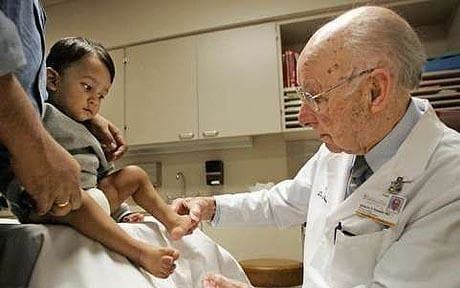Name Ignacio Ponseti | ||
 | ||
Died October 18, 2009, Iowa City, Iowa, United States Books Congenital Clubfoot: Fundamentals of Treatment | ||
Education University of Barcelona | ||
2007 cmn miracle awards dr ignacio ponseti
Ignacio Ponseti (3 June 1914 – 18 October 2009) was a Spanish physician, specializing in orthopedics. He was born on 3 June 1914 in Menorca, part of the Balearic Islands, Spain, Ponseti was the son of a watchmaker and helped repair watches. The skill was said to eventually contribute to his abilities as an orthopedist. He fled Spain during the Spanish Civil War and became a faculty member and practicing physician at the University of Iowa.
Contents
- 2007 cmn miracle awards dr ignacio ponseti
- A Walking Miracle The Ponseti Method for Clubfoot Treatment
- Biography
- Education
- The Ponseti Method
- World Clubfoot Day
- References

A Walking Miracle - The Ponseti Method for Clubfoot Treatment
Biography

In the 1950s Ignacio Ponseti developed the Ponseti Method (also known as the Ponseti Technique), its a non-surgical technique that uses a series of casts, followed by an abduction brace, to correct congenital clubfoot. The condition causes a baby's feet to turn inward and downward; if not corrected, a child is unable to walk or move properly. He was known for this method of clubfoot treatment that bears his name and was Professor Emeritus in the Department of Orthopaedic Surgery at University of Iowa Hospitals and Clinics. v-sat
Education
Ponseti studied medicine at Barcelona University. Not long after he graduated, fighting broke out between the Nationalists and the Republicans - the start of the Spanish Civil War. Ponseti served as a medical officer with the Loyalists as a lieutenant, then captain, in the Orthopaedic and Fracture Service. His duties included setting fractures, which put him on a career in orthopaedics. Without ambulances, Ponseti used the help of local smugglers to take the injured into France. He soon escaped to France himself and went to Mexico, where for two years he practiced family medicine. A physician there helped Ponseti get to Iowa in 1941 to study orthopaedics under Arthur Steindler, M.D. Ponseti completed a residency at Iowa in 1944 and became a member of the orthopaedic faculty at University of Iowa Hospitals and Clinics.
Early in his career at Iowa, Ponseti saw that the outcomes of clubfoot surgical treatments were not very good—patients had limited movement. He set out to develop a treatment that made the most of babies' flexible ligaments. The method was met with some opposition but over the past 50 years it has been adopted by many doctors and other health care providers worldwide, including in Britain and Turkey

Well into his nineties, Ponseti continued to see patients and trained visiting doctors from around the world. He also developed new prosthetic devices with John Mitchell of MD Orthotics [1] and produced training and information DVD's on the method.
Ponseti's other research focused on congenital and developmental bone and joint disorders, skeletal growth disorders in children, and the biochemistry of cartilage. He gained insight in the early 1950s on the effect of amino nitriles on collagen cross linking, defined the curvature patterns of idiopathic scoliosis, and demonstrated that curves progressed after skeletal maturity. He also conducted many studies evaluating the long-range results of treatments for congenital dislocation of the hip, clubfoot and scoliosis.
The Ponseti Method
Clubfoot affects well over 100,000 newborns annually. Early in his career at the University of Iowa, Ponseti realized that surgical approaches did not fully correct clubfoot and/or created problems later in life, such as severe arthritis or even requiring more surgery. In working to develop a new approach, he determined it could be nonsurgical. The Ponseti method uses gentle, manual manipulation of the foot, followed by application of toe-to-groin plaster casts. The casts are changed weekly after a clinician manipulates softened foot ligaments to gradually achieve near-normal muscle and bone alignment.
In addition to the improved physical outcomes, compared to surgery, the Ponseti method is less expensive and can be taught to nonphysician health care providers, which is useful in areas with few or no doctors. Nearly 80 percent of children born with clubfoot live in impoverished nations. The Ponseti method is used, for example, in Uganda, where efforts continue to improve the availability of the treatment.
Information about the use of Ponseti method can be found at these sites: World Health Organisation, American Academy of Orthopedic Surgeons, Pediatric Orthopaedic Society of North America, STEPS Charity UK and STEPS Charity South Africa.
At the 2007 International Clubfoot Symposium attended by 200 doctors from 44 countries, papers were presented regarding an estimated 10,000 children successfully treated with the technique around the world in the past few years.
The Ponseti International Association for the Advancement of Clubfoot Treatment was founded in 2006 to improve the treatment of children born with clubfoot through education, research and improved access to care. PIA has a related Web site devoted to the interests and needs of parents. Groups that work with Ponseti International include CURE International and A Leg to Stand On (India)and Pehla Qadam (one of the organizations in Pakistan).
World Clubfoot Day
World Clubfoot Day was introduced in 2013 by Ponseti International Association and is celebrated on June 3 every year. This date was chosen following the signing of the Iowa Clubfoot Declaration during the 2nd International Clubfoot Symposium held in Iowa City, Iowa, USA, on October 4 – 5, 2012. The date commemorates the birthday of Dr. Ignacio Ponseti, M.D. (1914-2009), the developer of the Ponseti Method to treat clubfoot.
The goal of World Clubfoot Day is to raise awareness about clubfoot disability and its prevention using the Ponseti Method, a non-surgical treatment that includes gentle manipulation of the feet followed by the application of plaster casts and temporary bracing. Clubfoot is the most common musculoskeletal birth deformity, affecting 200,000 newborn children each year, 80% in developing countries. There are also hundreds of thousands of children and young adults who are living with this debilitating condition worldwide. The Ponseti Method is nearly 100% effective when properly applied by a trained health care provider and is considered the "gold standard" treatment, leading to a normal, productive life.
